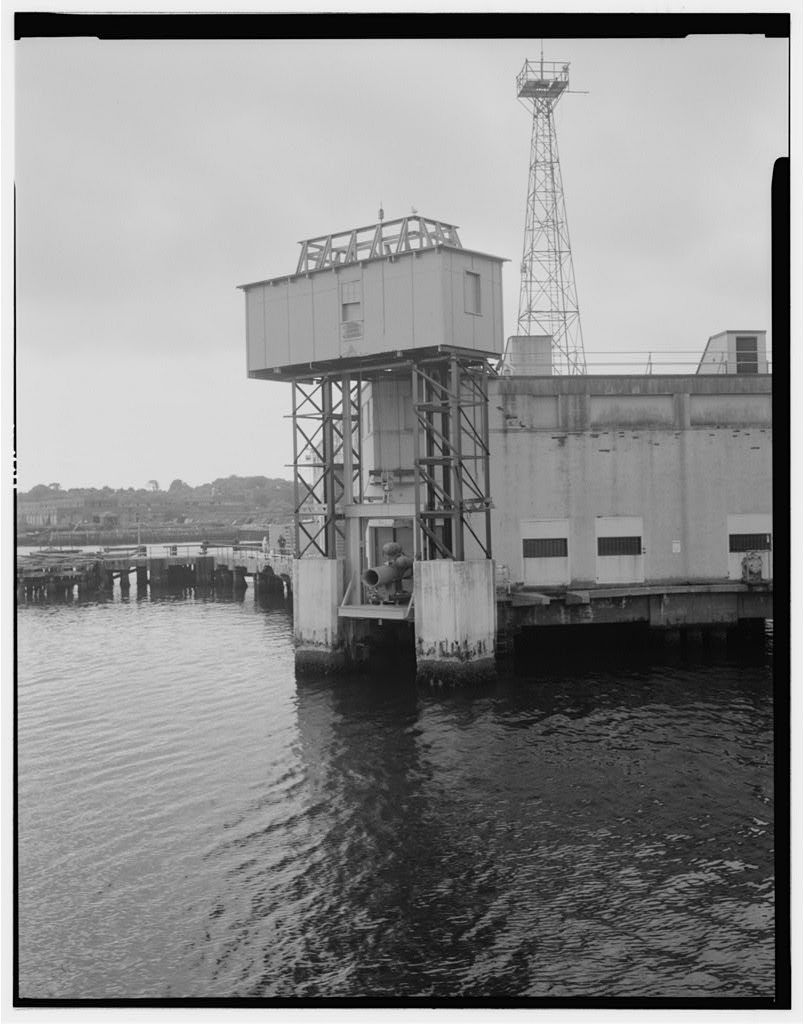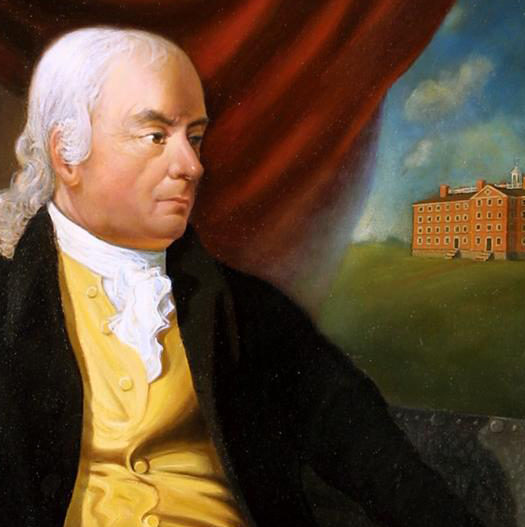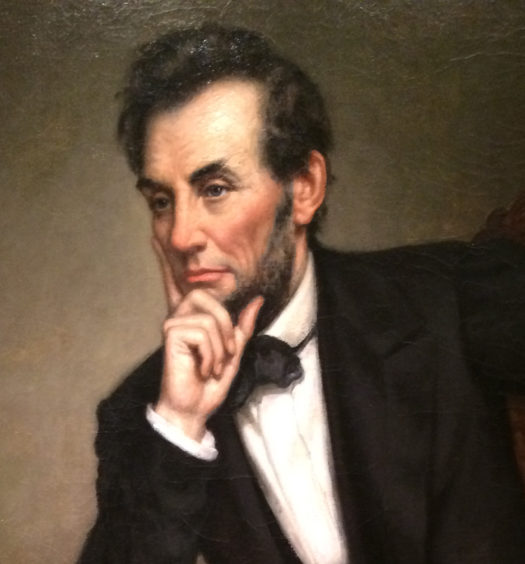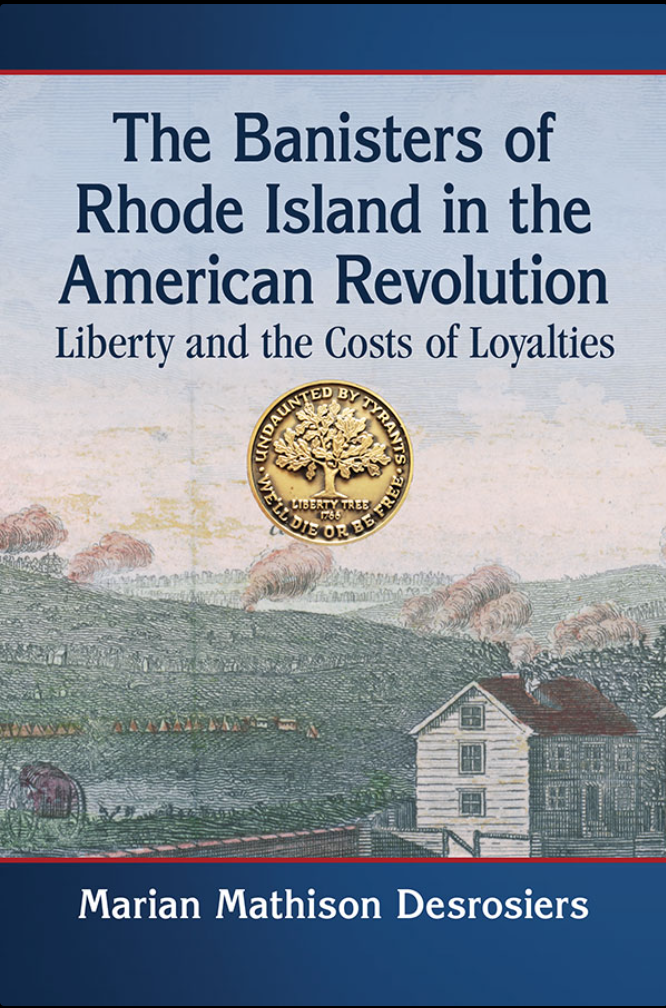In 2018 and 2019, in celebration of the 1869 founding of the Naval Torpedo Station at Newport, Rhode Island, and its newer designation as Naval Undersea Warfare Center Newport, several publications recounted the hiring of women. The authors wrote that no women in science or engineering were hired until the 1960s. There was one outstanding woman they missed, my mother, Genevieve McGlinchey Mathison (1911-2004)!
From an early age Genevieve McGlinchey enjoyed science of the natural and the mechanical world. Her childhood home, not far from Harvard Square in Cambridge, Massachusetts, meant an opportunity to explore the Peabody Museum of Archaeology and Ethnology. With her father, Genevieve viewed the stone tool technology of Europe, objects from the Lewis and Clark Expedition, and artifacts from the Mayans. The Agassiz Museum of Natural History included models from worldwide species, gems from geological expeditions, and the Glass Flowers created by Leopold and Rudolf Blaschka from Dresden. These experiences were an introduction to the various fields of science that encouraged a young girl to think of the possibilities for her future.
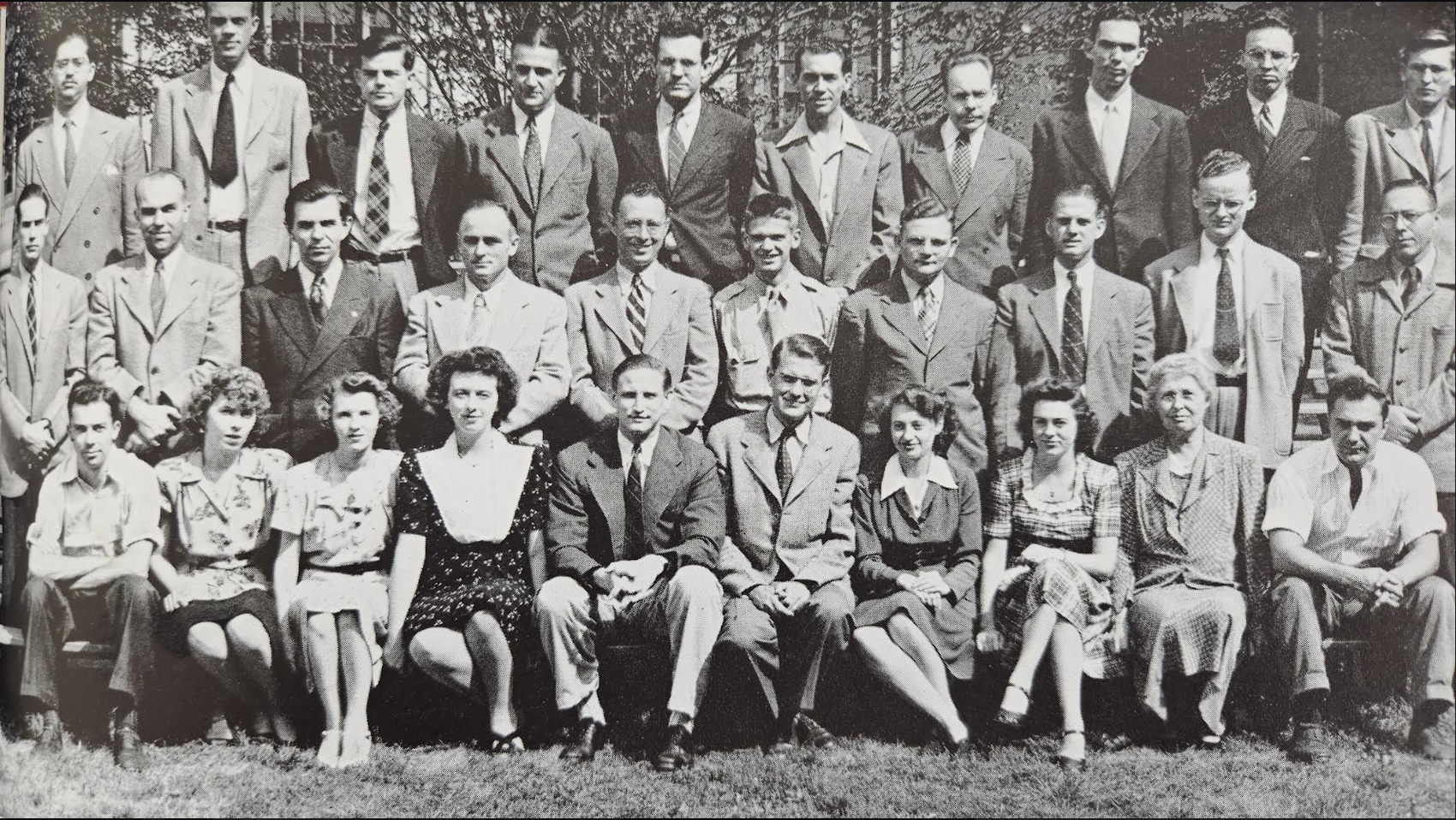
Genevieve Mathison, “Group 42, Propagation,” M.I.T. Radiation Lab, Cambridge, MA, 1945. Genevieve is sitting in the bottom row, fourth from the left.
The opening decades of the twentieth century saw practical applications of scientific discoveries. In 1919, her father had Genevieve assist him in making a radio from a kit. The young woman learned about invisible radiation, vacuum tubes, transmitters, and receivers. The family had an RCA hand cranked phonograph, whose invention elicited more questions about the science of sound waves. There was an opportunity to learn basic physics while assisting her dad in the repair of the pulley/weight system for the heavy windows in their 1857 home. As with many do it yourself projects of her dad’s, Genevieve was invited to be curious and assist.[1]
Such was the early exposure to science for a woman who would crack the mold of mainly men hired for scientific/technical positions in the testing/design of torpedoes in 1951. However, she would put in years of work to get to that point. In 1928, Genevieve graduated second in her class of 390 students at Cambridge Latin School, where she received the Award for Excellence in Chemistry and Physics and a Hopkins Scholarship to Radcliffe College in Cambridge.[2]
In 1932, Genevieve McGlinchey graduated with an AB in chemistry, having been taught physical organic chemistry by Dr. James Bryant Conant (1893-1978).[3] Also, Paul D. Bartlett (1907-1997) was one of her instructors, while he worked toward his PhD under Dr. Conant from 1928-1931. Professor Bartlett went on to become the dominant physical organic chemist in the field for the next four decades.[4] Having such extraordinary professors provided McGlinchey with a glimpse of a possible career, while recognizing that men would dominate the field.
Never one to be deterred by numbers, under ordinary circumstances McGlinchey might have pursued a graduate degree in chemistry, but 1932 was the height of the Great Depression. Genevieve’s father passed away before her college experience ended, making her the sole support for her mother, aunt, and two younger sisters. She went to work in Cambridge as a substitute teacher by day and at night school.[5] From 1938 to 1944 she held a permanent appointment, teaching science.[6] She also continued her professional development at Harvard Graduate School in both education and science.[7]
Summers she worked at Harvard laboratories, earning $100 a month as a research assistant. First, she was at Byerly Laboratory, Radcliffe (built in 1931). Professor Charles H. Greene (1904-1990) taught Chem 4: Quantitative Chemistry and designed experiments for students.[8] McGlinchey and three “computers” (the title assigned to Radcliffe undergraduate mathematics majors) contributed to Greene’s publication.[9]
She also assisted Dr. Bartlett at Harvard’s Converse Laboratory (built in 1928), supervising student research on organic reactions for Chem 5 Advanced Organic Chemistry.[10] Genevieve met students in a nearby lab, who were researching the atabrine molecule with Dr. Robert Burns Woodward (1917-1979). The experiments focused on developing an anti-malarial drug, which became known as synthetic quinine (atabrine) for U.S. troops in the Pacific.[11] For McGlinchey it was stimulating to be working again in science with top chemists in the field, who were young as she was.
Meanwhile, Genevieve determined to achieve a graduate degree in physics at Boston College from 1942 to 1944, taking the German and French scientific language exams, completing course work in acoustics, mechanics, optics, and statistics. She submitted her thesis: Absorption Spectrophotometry by Means of the Logarithmic Sector in June 1943. Genevieve received her master’s degree in physics in 1944. She used an analytical technique to measure wavelength and frequency of a light source (electromagnetic radiation) absorbed by several chemical substances.[12] She was poised to move into a career as a scientist!
Radiation Laboratory, Massachusetts Institute of Technology, Cambridge, Massachusetts
From July 1944, Genevieve held a federal war time lab job with other civilians working to develop effective “RADAR” (radio detecting and ranging). Genevieve was the type of person they hired: “studious, intelligent, young, and energetic.” The nuclei of the Radiation Lab were young physicists, mostly men from universities with another three hundred fifty from industry (such as Bell, GE, RCA, and Westinghouse). The individuals with whom she interfaced were no less than the rising stars of world physics.[13]
McGlinchey took the job at the end of her high school teaching year, starting at MIT in July 1944 at $220 per month ($2,640 per annum). McGlinchey’s first assignment focused on X-Band radar, working under Dr. Edward M. Purcell (1912-1997). He would later be credited with the discovery of “nuclear magnetic resonance,” one of the most important medical advances of the twentieth century.[14] The lab group also worked to improve the magnetron, an electron tube in which they generated microwaves (a flow of electrons) by applying a magnetic field. Dr. Carol G. Montgomery (1909-1950) from Yale, supervised Genevieve’s work with five others on the experiments, computations, and resulting graphs.[15]
From July 1945 to the closing of MIT Radiation Lab at the end of the year, Genevieve worked on experiments to resolve problems encountered with K-Band radar, such as the effect of atmospheric conditions on waves and effects of sea echoes. Genevieve’s supervisor was Dr. Herbert H. Goldstein (1922-2005) with his PhD from MIT in 1943.[16] The group did measurements of microwaves over water. Long Range Navigation (LORAN) was one outcome of that research and used in the Pacific theater of the war by August 1944.[17] Much of the team experience involved working with differential equations and calculus.[18]
McGlinchey enjoyed her job for three reasons. The research environment was filled with committed, creative colleagues and brilliant mentors. It was heady stuff to be surrounded by such intelligence and dedication to one’s job. Secondly, at Radiation Lab her salary (after a raise) was remunerative at $240 per month or $2,880 per annum. Her salary was higher than she would have earned as a public high school teacher. She also met her future husband, physicist and electrical engineer, William Wallace Mathison (1913-1988), who had two degrees, a BS and MS in physics from Boston College. Over her eighteen months at Radiation Lab, she gained an understanding of the value of being a research scientist, while surrounded by extraordinary individuals, all the while doing her part collaborating with mostly men for the war effort.
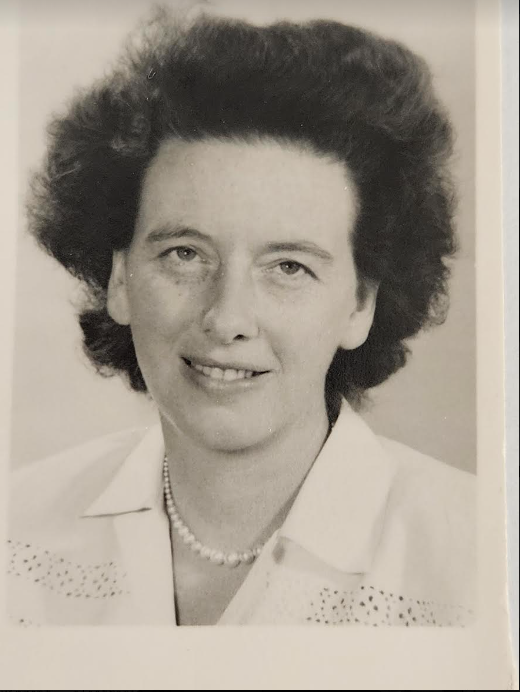
Genevieve Mathison, Sept. 1950, either as scientist at the Naval Ordnance Test Station, NOTS, China Lake, CA, or as China Lake School System Science Supervisor
Naval Ordnance Test Station (NOTS), China Lake, California
With World War II officially ending September 2, 1945, Radiation Lab was set to close at the end of that year. Genevieve and her husband of one year, Wallace Mathison, requested a transfer to the west coast lab, the Naval Ordnance Test Station (NOTS) in Inyokern, California, 150 miles north of Los Angeles in the Mojave Desert. In early 1946, Radiation Laboratory assisted civilians to transition toward their choice of relocation. Her husband secured a job along with fourteen other male scientists from Rad Lab. Genevieve was disappointed. Of the five women with advanced degrees who worked with Genevieve in Group 41 or 42, three took their next job in university settings, one in industry, and one at Maria Mitchell Observatory.[19]
The Mathison couple took turns driving their 1938 Cadillac across the country from the Boston area to southern California; Sally, their first born, just a few months old, joined the westward bound parents. Since there was nothing like an interstate highway system, they traveled mostly two-lane roads over the 3,600 miles before arriving at China Lake Naval Ordnance Testing Station [NOTS], California. They would be situated there for nearly six years.[20] The “navy base” in the middle of a desert was somewhat of an anomaly. About the size of the state of Rhode Island, the government built a city of research for civilian scientists and their families.[21] A beautiful setting with plenty of sunshine, the sandstorms were wild, and the summer heat blistering, often reaching 130 degrees Fahrenheit.[22]
At NOTS, her husband Wallace’s work on the missile trials of the “Sidewinder” involved measurements from inside a bomber plane while sitting on a crate. At nine feet in length the Navy considered the missile relatively inexpensive, uncomplicated in moving parts, and needed no more electronics than a radio. In 1946-1950 he along with other scientists experimented with size, weight, speed, flying height, and angling to overcome problems with “the guidance system which was irritatingly imprecise.” By 1952, the missile was deployed.[23]
NOTS years were busy. In March 1947, the couple welcomed a second daughter, Marian (the author). Again, Genevieve focused on professional growth taking science courses long distance.[24] In 1949, Genevieve took on a year-long contract in the Michelson Lab at NOTS. The Evaluation Department on training and installation used the IBM 604 Electronic Computer to collect data on the pattern of missiles in flight. Mathison’s job was to check results against the theoretical equations of what the missiles should do in flight.[25]
By 1950, Mathison secured the science supervisor position at China Lake and taught students from kindergarten to grade eight as well as workshops for teachers. She received a salary of $348 per month or $4,176 per year for that appointment.[26] With two children under four years of age this was a better fit for the family.
When the Mathison couple learned of openings at the Naval Torpedo Station, which was being expanded and rebuilt on a new site in Newport, Rhode Island, they applied. Both received employment letters in the summer of 1951. Genevieve received a GS-9 rating and the title of physicist in the Research and Development Department at a salary of $316 per month or $4,600 per year. They learned that their first day of work was October 1, 1951.[27]
Naval Underwater Ordnance Station (NUOS) Newport
Having visited nearly all the National Parks of the Great American West, the family headed back to the east coast. Both Genevieve and her husband, William Wallace Mathison, started work at the Naval Underwater Ordnance Station (NUOS) in Newport, Rhode Island, which was expanding its facilities to twelve buildings on the 163 acres at Coddington Cove on Aquidneck Island in Narragansett Bay.[28]
For Mathison, the job at the new research facility was a chance to return to her intended career path nearly twenty years after earning her first degree in the sciences. She was known as a person with a prodigious memory who wanted to tackle problems. Genevieve Mathison, at the age of forty, was hired as Physicist (Applied), Acting Head of the Acoustics Section, Physics Research Branch, and Acting Head of the Hydrodynamics Section of the Hydro ballistics Research Branch, Department of Research and Development. Originally called the Newport Torpedo Station, in December 1951, the name of the facility changed to the Naval Underwater Ordnance Station (NUOS).
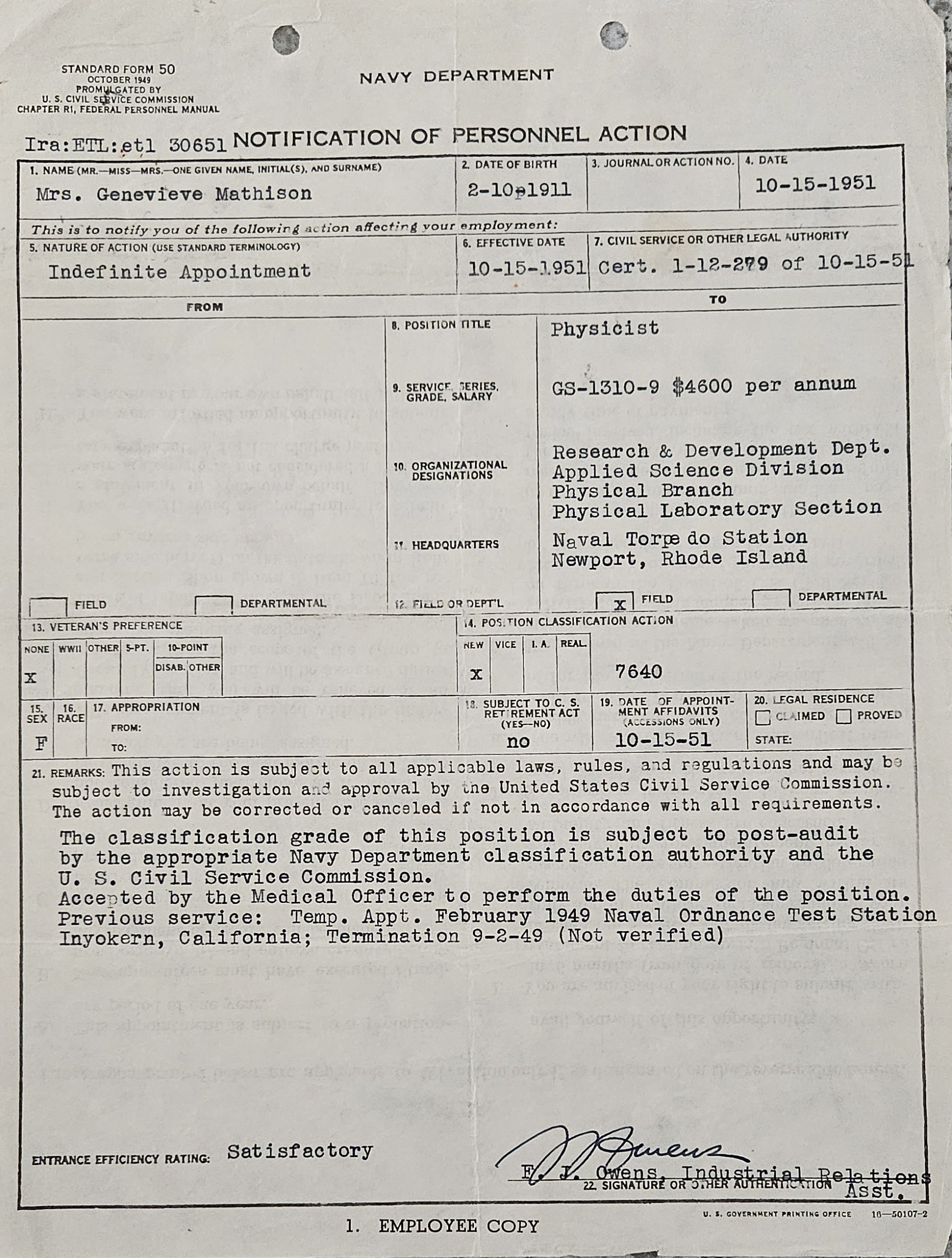
Naval Underwater Ordnance Station, NUOS, Newport, RI Notification of Personnel Action for Genevieve Mathison with a GS-9 Physicist Rating, Oct. 1951
Combined gross income for the spouses (Wallace was an electrical engineer) was about $9,000, made possible the purchase of a newly constructed ranch house in the south end of Aquidneck Island, a mostly rural area called “Bancroft Meadows” close to Bailey’s Beach and Bellevue Avenue Gilded Age mansions.[29]
During the time the contractors built the prefabricated house in the fall of 1951, Genevieve and Wallace commuted by automobile from the 1867 McGlinchey family home in Cambridge to the Navy Base in Newport—160 miles roundtrip every day on one lane roadways! Genevieve’s mother and aunt, in their late seventies, took care of the two older girls who attended school. Aunt Alice Mathison Engstrom, husband Frank, and two teenaged daughters lovingly attended to ten-month-old baby Betsy in New Haven, Connecticut, until the family moved into the Newport house in January 1952.[30]
The male engineers at the base called Genevieve, “Wally’s wife.” Arthur C. Coogan (1895-1983), Dick M. Dunlap (1918-2014), Gerry G. Gould (1922-2010), Jack Greichen (1931-), Earle L. Messere (1932-2019), Morrie P. Seiple (1921-2015), and Charlie Soliozy (1925-2020) remained life-long friends and helped her start the Engineering Society of Newport County. Only one of these men is still alive but my interview with him revealed several interesting memories of life at NUOS from 1953 to 1955. He stated:
Genevieve Mathison was there in instrumentation when I worked at the Base. She did measurements on beam width, amplification, and noise levels at the Gould Island range where they fired the so-called tin fish (torpedoes) toward the area where the Pell Bridge is now.” Hydrophones were positioned at the bottom of Narragansett Bay five hundred yards east and west of the pier and two at the thousand-yard mark. A pair at the two thousand yard, three thousand yard, and four-thousand-yard marks each were five hundred yards east and west of the center line of the torpedo range.[31] Instruments inside the torpedo relayed the information about speed, depth, length of run. No live explosives were on these test torpedoes; instead, there was a head that would blow out water as the torpedo surfaced. However, there were torpedoes that went astray. The Navy offered $200 to anyone finding one—a necessary feature for retrieving a torpedo which cost thousands of dollars to produce.[32]
The torpedoes traveled a 10,000-yard course in the bay tracked by hydrophones to measure the coordinates of its trajectory. Data and calculations assisted in correcting the deadly habit of the Mark 14 to circle back on the firing ship after deployment.[33]
Genevieve Mathison’s work on calibrations of the anti-ship submarine launched Mark 14 and the Mark 16 Mod 4 torpedo led her to take an active part in the testing launches, traveling back and forth by boat between Newport and Gould Island. On some days travel on the motor launch meant the ocean spray soaked her. Because the rule was no women in the wardroom, she ate a bag lunch on deck. In those days she was the only woman on board.[34]
Occupying fifty acres of land, Gould Island had buildings and a massive pier for the above water and underwater testing devices. First established in 1869, it had played a key role for the U.S. Navy as recently as World War II.
Reflecting on how it happened that she was hired as the first woman physicist at NUOS, Mathison believed her selection was due to her education and her varied experiences in applied physics. Her job description was: “to conduct feasibility studies and design/plan facilities evaluations for acoustic instruments for measuring torpedo performance in deep water and acoustic target systems.” The data she analyzed included studies of frequency ranges, amplitude, beam patterns, impedance, and resistance.
One goal was to determine sources of torpedo noise and methods for suppression of the noise by use of the best instrumentation, particularly properly calibrated hydrophones in the acoustic tunnel or tank. Mathison’s work in torpedo hydrodynamics involved experiments on flow, pressure, temperature, cavitation, and drag. Mathison noted that her contacts with other specialists at NUOS were essential, especially the Materials Research Branch and the Chemical Research Branch. Mathison conferred with other engineers at Ordnance Research Lab (ORL) at Penn State University. She also read extensively about the research of contemporary British, German, and Italian scientists.[35]
From October 1951 through June 1953, Mathison’s immediate boss in the research division was Dr. William W. Bartlett from October. Mathison’s publications with her supervisor Dr. Bartlett include these numbered “Inside the Navy Reports [hereafter ITN]:”
ITN #112-55 “Low Frequency Noise Measurements of the MK 35 Mod 2”
ITN # 155-52 “Torpedo Noise”
ITN # 171-53 “Torpedo Machinery Noise Studies on the MK16 Mod 7”
ITN # 180-53 “Torpedo Noise Conference”
ITN # 241-53 “A Survey of the Data Analysis Needs for the Test and Evaluation Department”
ITN #267-53 “Self-Noise of the Torpedo MK35 Mod 2” (This was the first torpedo evaluated in the Wind Tunnel)
ITN # 270-53 “Sonic Noise of the MK 35 Mod 2 Torpedo in the Air” [36]
With three years of steady performance Mathison was promoted to Physicist (Sound) GS-11 at a salary of $6,390 per annum.[37]
By the end of her six years at NUOS, Mathison was a key member of its workforce. She proved her worth to the lab as project engineer on the acoustic tank and wind tunnel and on the hydrodynamics section. The acoustic tank was essential to noise reduction on the torpedoes propulsion system, whether electrical, reciprocating engine, or turbine types. The advantage was that measurements could be made more economically and conveniently than on the range.
As a scientist her eventual annual salary of $7,250 represented what a professional woman could attain in a federal facility.[38] Genevieve was one of 830 civilians working at NUOS in 1957.[39]
Mathison was not only a talented and hardworking scientist, but she had a family. Therefore, she volunteered in the Newport community to serve as a program chair of the Carey Elementary School Parent Teacher Association, Girl Scout Leader, Science Fair Judge, and as Red Cross First Aid Instructor. Genevieve was a leader in the local fund raising by the American Association of University Women to award scholarships to girls in Newport graduating high school and planning a career in the sciences.[40]
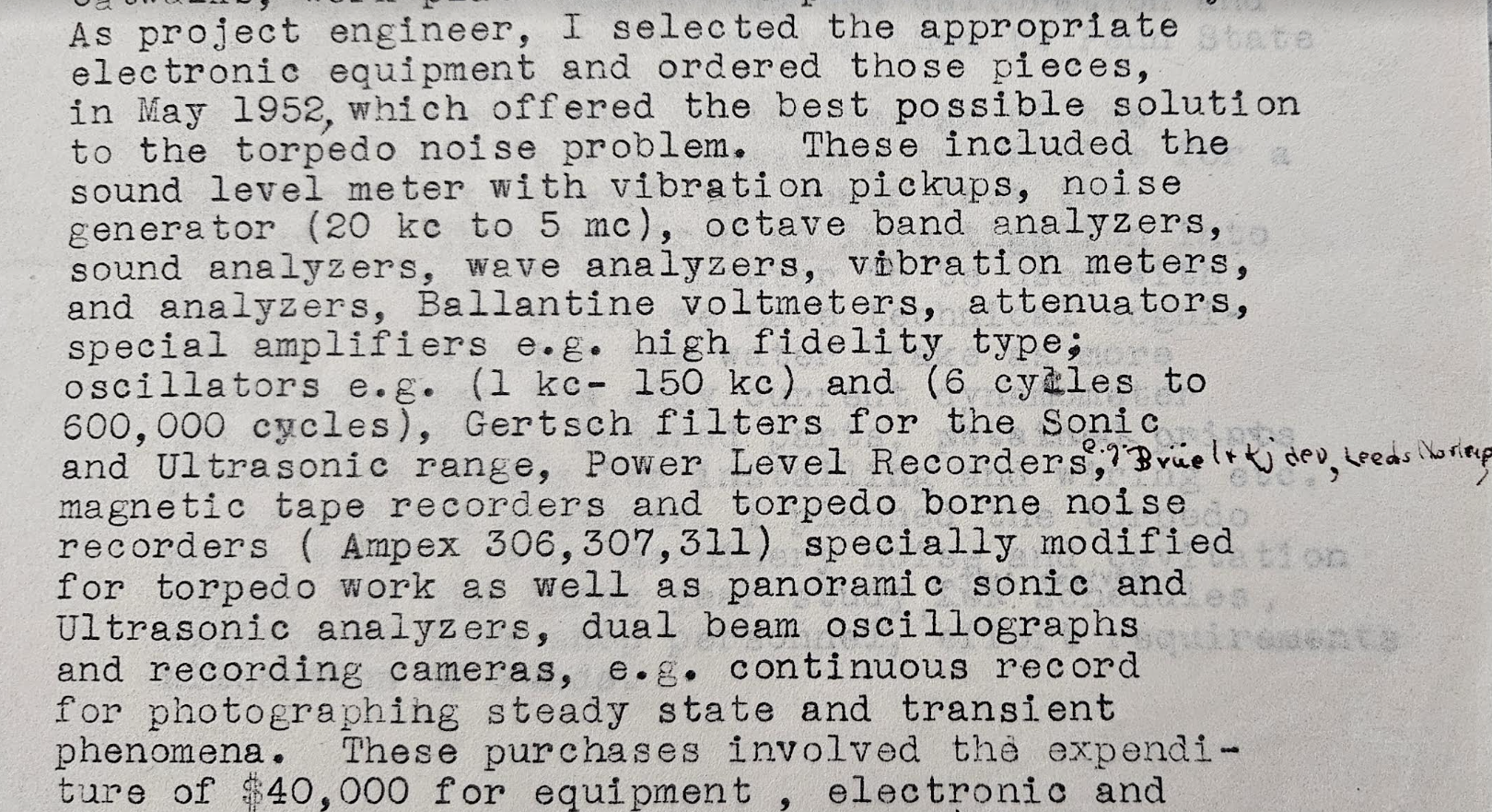
Statement by Genevieve Mathison, Project Engineer for the Acoustic Tank, Research Division, Torpedo Design and Development, NUOS, 1953
The Next Step
In 1957, Genevieve Mathison decided on a career move in the sciences. The position opened for the head of the science department for the Newport Public Schools at an annual salary of $7,800. She determined that she could affect future generations by attaining a position that allowed her the authority over the science curriculum. (At the time her friend, Rhode Island Senator Florence Kerins Murray (1916-2004), became a first-year judge in Rhode Island and earned an annual salary of $15,000.)
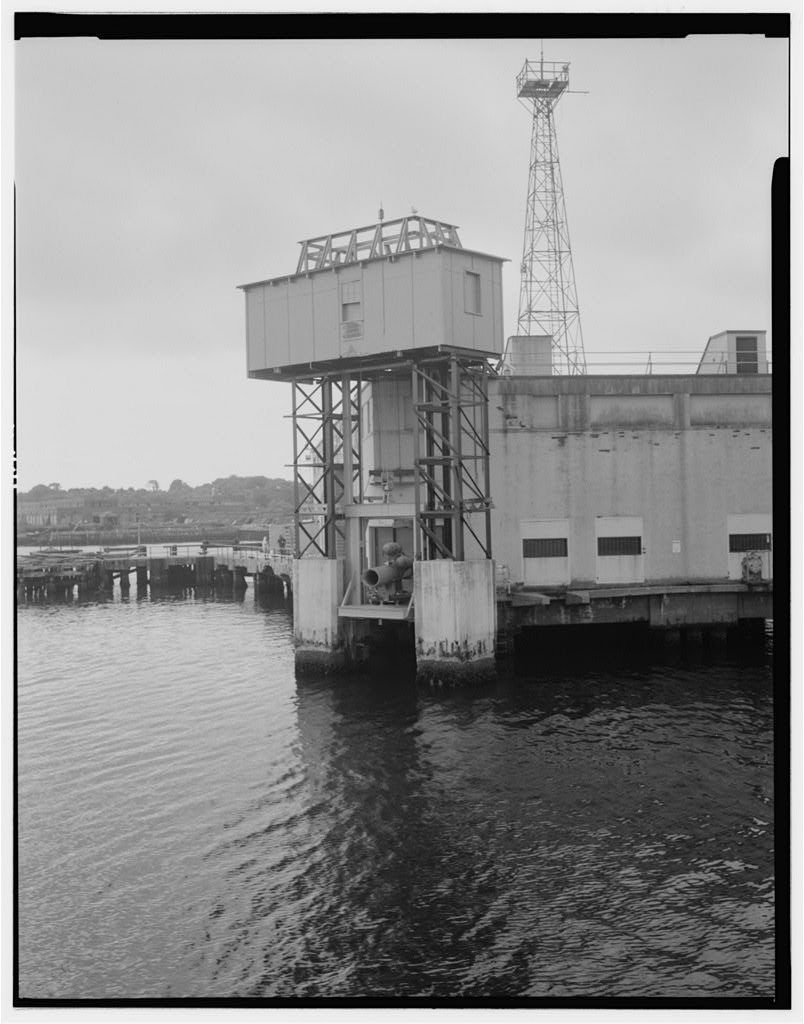
Naval Torpedo Station, Firing Pier, north end of Gould Island in Narragansett Bay. The firing pier was a large platform from which torpedoes were launched into an underwater testing range in Narragansett Bay. After World War II, NUOS used the firing pier to test experimental models (Library of Congress)
Over the next three years, Department Head Mathison increased the quantity and variety of science laboratory equipment for junior high and high school. She initiated science training for all levels of teachers, especially for elementary school where understanding and love for science begins. Mathison started the Aquidneck Island Science Fair (including Middletown and Portsmouth as well as Newport) to prepare students and teachers for national competitions, such as the Westinghouse Science Scholars. As a teacher of physics at Rogers High School, one of her students Paul Bamberg became the first Rhode Island student to become a Westinghouse Science Talent Search Scholar (1959).[41] From 1952 to 1957, as the only woman in the Newport Engineering Society (NES), Mathison crafted the goals of the organization, inviting high school women to attend lectures and qualify for scholarship awards for excellence in science.[42] Genevieve McGlinchey Mathison continued her legacy, a woman pioneer in science, furthering science education for others.
Genevieve McGlinchey Mathison continued her legacy, a woman pioneer in science, furthering science education for others.
Notes:
[1] Interview of Genevieve Mathison with the author, Newport, Rhode Island, Jan. 9, 1993. [2] “Cambridge High and Latin Graduates Class of 390,” Boston Globe, June 13, 1928. [3] Paul D. Bartlett, “James Bryant Conant,” Biographical Memoirs, National Academy of Sciences vol. 54 (1983): 91-124. After earning his PhD at Harvard in 1916, his published research was on hemoglobin, chlorophyll, and thermodynamics. He was President of Harvard University from 1933-1953, but also served on the NDRC to develop the atomic bomb (the Manhattan Project). He later became ambassador to West Germany. [4] F.H. Westheimer, “Paul Doughty Bartlett,” Biographical Memoirs, Nat. Acad. Sci. vol. 75 (1998), 24-36. [5] Interview of Mathison with the author, Jan. 1993. [6] Edward J. O’Connell, Secretary of the Cambridge, Massachusetts School Committee to Genevieve McGlinchey. Appointment as teacher in the Webster School 1 Sept. 1936, 1937, and 1938. Genevieve McGlinchey, Appointment as teacher of Science at Cambridge Latin, 1939. [7] Harvard Graduate School of Education, Transcript of Genevieve McGlinchey for 1940-1942. [8] Interview of Mathison with the author, Jan. 1993. [9] C.H. Greene, “Solubility of Barium Nitrate, Strontium Nitrate and Calcium Nitrate in Concentrated Nitric Acid,” J. Am. Chem. Soc. 1937, 59, 7, 1186–1188 (1 Jul.1937). Access at https://doi.org/10.1021/ja01286a008. Greene received his PhD in 1931 and taught at Harvard through 1937. “NSF Grant Awarded,” Fiat Lux, vol. 45: No. 13 (14 Jan. 1958). His study was on the strength of glass; he was department head at Alfred University to 1970. [10] P. D. Bartlett, “Preparation of Dye Intermediates: Ortho, Meta, Para Diphenyl, Diethyl, Carbinol Compounds Crystalline Form by Various Methods.” J. Am. Chem. Soc. 1942, 64, 11, 2649–2653 (1 Nov. 1942). https://doi.org/10.1021/ja01263a035. This research had applications for Shell, Polaroid, and the Office of Scientific Research and Development (OSRD). [11] The 1940s Japanese conquest of Indonesia, Myanmar, Papua New Guinea, the Philippines, and Vietnam cut the rest of the world from the supply of cinchona, the plant which was the source for anti-malarial drugs. Elkan Blout, “Robert Burns Woodward,” Biographical Memoirs. National Academy of Sciences (2001) 80: 1-23. Access at: http://www.nasonline.org/publications/biographical-memoirs/memoir-pdfs/woodward-robert-b.pdf. See also Erin Miller, “The Grandfather of Organic Chemistry: Robert Burns Woodward, PhD.” Labmedicine, 2010, 41: 245-246. http://www.nap.edu/html/biomems/rwoodward.html. Attaining his PhD at age twenty, Woodward spent forty years at Harvard. He received the Nobel Prize in Chemistry in 1965 for his synthesis of numerous medicines, to name just a few, cortisone, tetracycline, erythromycin, steroids, reserpine, and cephalosporin, and Vitamin B12. [12] Genevieve McGlinchey Thesis, CO141619, Burns Library, Boston College, Chestnut Hill, MA. Mathison interview with the author, 1993. George Kistiakowsky (1900-1982) was a faculty member in the Harvard chemistry department when McGlinchey was at Radcliffe, and she first learned from him about the field of spectroscopy and the use of spectrophotometry. [13] Charles Newton, Thelma E. Peterson, Nancy Joy Perkins, Five Years at the Radiation Laboratory (Andover, Massachusetts: Andover Press, Ltd., 1946), 8-12, 32-33. The average age of the 3,897 workers was thirty-two. Four hundred twenty-one women and men had graduate degrees in optics, astronomy, physics, meteorology, chemistry, botany, math, and geology. [14] Ibid. 112-115. Author of the classic college text on Electricity and Magnetism (1963), Purcell received the 1952 Nobel Prize in Physics for study of magnetic fields of atomic nuclei. [15] Dr. Montgomery published a paper, “Experimental Methods, Microwave Radar,” part of the Waveguide Handbook in the MIT Radiation Lab Series. Montgomery edited vol. 8, 11, and 14. He was known for building an early linear electron accelerator in 1941. Scientists at the Radiation Laboratory also worked on Project Affirm, the development of radar for American fighter planes to attack at night. Testing of the radar during wartime occurred at Spraycliff Observatory at Jamestown, Rhode Island, and is described in an article by Varoujan Karentz, which can be viewed here: http://smallstatebighistory.com/beavertails-top-secret-spraycliff-observatory-world-war-ii/ [16] Five Years at Radiation Lab, 112. He used land contours of the Blue Hills to try to determine how the United States might detect incoming enemy planes. Dr. Goldstein later in his career developed models for nuclear power plant design and shielding. [17] Ibid., 18, 45. Also, in her research group was Julian Schwinger PhD (1918-1984), working on E-Plane experimental radar; he received the Nobel Prize in Physics in 1965 for his work in quantum electrodynamics. [18] Mathison interview with the author July 1993. [19] Staff Member Placement Survey (Cambridge, MA: Radiation Laboratory, MIT, 31 Jan. 1946), 38, and the index. Sixteen of the seventy-five women in professional research positions (not considered secretaries or clerks) received assistance in placement to a university or similar setting. The number seventy-five is based on women with college degrees and their thesis or work experience listed next to their names in Radiation Laboratory Staff Members (Cambridge, MA: Radiation Laboratory, MIT, Jun. 1946). Twenty-one were mathematicians, sixteen had degrees in physics, seven in astronomy, and six in chemistry. At full capacity, including machinists and secretaries, the work force at Radiation Lab was close to four thousand workers. [20] Mathison Interview with the author, July 1993. [21] US Naval Ordnance Test Station, Inyokern China Lake, California, June 1950. Pamphlet prepared for new civilian residents of the base, 1-3 pages. The nuclear bomb dropped over Hiroshima was assembled in the far reaches of the Mojave. B-29 bombers flew onto the desert floor without the knowledge of the public. [22] Genevieve Mathison, China Lake, California letter to her uncle, Right Reverend Monseigneur Joseph P. McGlinchey, DOD, Lynn, Massachusetts, Aug. 9, 1947. [23] Interview with William Wallace Mathison (1913-1988) by the author, July 1988. Babcock, Elizabeth Babcock, Sidewinder Invention and Early Years, The China Lake Museum Foundation, 1999. The name was selected in 1950 because the Sidewinder rattlesnake uses infrared sensory organs to hunt its warm-blooded prey. Prime contractors with the Navy who manufactured the Sidewinder were Philco and General Electric. The high explosive missile traveled at Mach 2.5 at a range of six to eight miles and at a ceiling of 18,000 feet. The guidance system that evolved allowed the missile to angle toward the target, whether traveling faster from behind or homing into the target from in front. [24] University of California Transcript for Genevieve Mathison 1949-1950. Teaching Credential for Genevieve Mathison, Secondary Education Credential, #B39801. [25] R.W. Anderson, Industrial Relations for the Department of the Navy to Genevieve Mathison, hiring letter as a Mathematician in the Department of Aviation Ordnance and Test Measurements at the NOTS Michelson Lab for Guided Missiles (built in 1948). [26] “School District Hiring Contract,” W.W. Plum PhD was Chairman of the China Lake School District. Plum went on to work at the Radiological Defense Laboratory in San Francisco. [27] Appointment letter from F.J. Owens, Industrial Relations, Naval Torpedo Station, Newport, Rhode Island to Genevieve M. Mathison, China Lake, California, 12 Jun. 1951. Letter from F. J. Owens on 6 Sept. 1951 with start date of Oct. 1, 1951. At the time, a four door Buick sedan cost about $2,600, a twenty-inch Motorola television was $260, and a 7cu. ft. Sears refrigerator was $230. [28] Newport Daily News, May 9, 1952, 10. Microfilm Reel 0259, Sargent Collection, Newport Public Library. One of four centers (China Lake, Penn State, Keyport, WA) to design and develop torpedoes, NUOS was built at a cost of $ two million. [29] Mathison Federal Income Tax Form for April 1951. William and Genevieve Mathison paid $10.00 to T.J. Dwyer and Company, Feb. 11, 1952. Newport City Hall, Land Evidence 177: 514. [30] Mathison Interview with the author, July 1993. [31] Jack Greichen (1931- ) telephone interview with the author in Newport, Rhode Island, August 21, 2023. Greichen was aged 92 at the time of the interview. For the decade of the 1960s Greichen was Program Manager with Atlantic Undersea Testing and Evaluation Center [hereafter AUTEC] in the Bahamas. He worked in various branches or departments at NUOS, as a civilian employed by the federal government for forty years, retiring in 1993. Arthur Coogan was Deputy Technical Director and Dick Dunlap, the Director of Testing and Evaluation Division when Mathison started at NUOS. [32] Capt. Frank Snyder Ret. USN (1926-2017) “A Gould Island Chronology,” Jamestown Historical Society, Aug. 2003. [33] Kaull, James T. “Underwater Ordnance Station Strives to Give Fleet More Effective Torpedo, “Newport Daily News, Mar. 1, 1957, 14. Toward the end of World War II, the Torpedo Station was trying to determine what caused the Mark 14 to explode before hitting the target or entirely miss the target. Other torpedoes of the war era were Mark 13 deployed from aircraft and PT boats and Mark 15 from destroyers. See also Wallin, “Torpedo Station at Newport.” [34] Mathison interview with the author, July 1993. Both torpedo models were about twenty feet in length and twenty-one inches in diameter with a speed up to forty-six knots. The Mark 14 traveled 2.5 miles while the Mark 16 went over six miles. Both types were replaced in 1972 with the MK 48 at a speed of twenty-eight knots, reaching a depth of 1200 feet, with accuracy of five miles. For an article on the Torpedo Station’s role in World War II, including at Gould Island, see Brian L. Wallin, “The Torpedo Station at Newport,” in Christian McBurney, et al., World War II Rhode Island (History Press, 2017), 19-30. [35] Genevieve Mathison report as a GS-9 to William Bartlett, #8520 summarizing her first six months of work in the lab, from Oct. 1, 1951 to March 31, 1952. [36] Box of INT reports, Naval War College, Newport, RI. [37] Employee Payroll Copy, 1952, 1953, Personal files of Genevieve Mathison, Newport, RI. Her salary rose from $5060 per year in September 1952, to $5310 in May 1953, to $5940 in Sept. 1953. Performance Rating for Mrs. Genevieve Mathison, Employee Copy, signed by R. W. Caine, Industrial Relations Officer, NUOS, 5-20-1954. [38] Letter of H.C. Maynard, Commanding Officer of NUOS to Mrs. G. Mathison, Test and Evaluation Department, “Local Length of Service Awards,” Oct. 26, 1956. Payroll Employee Copy 1954, 1956, 1957, Personal files, Newport, RI. There were financial improvements in her salary in Dec. 1954 $6,605; Jul. 1956 $7,035; Jun. 1957 $7,250. Mrs. Genevieve Mathison, Payroll Change Slip, Employee Copy, Signed by R.W. Caine, Industrial Relations, 1957. James T. Kaull, Newport Daily News, Mar. 1, 1957. [39] Newport Daily News, Mar. 1, 1957. Gerry Gould, Technical Director for NUOS interview. [40] Kaull Part 4 “The New Rogers High School: The Science Department,” Newport Daily News, 17 Jan 1958 (earlier parts on RHS on 8 Nov, 16 Nov, 3 Dec 1957). Newport Daily News articles from 1953- 1960. [41] Honors in the Eighteenth Annual Science Talent Search for Westinghouse Scholars, 1959. https://sspcdn.blob.core.windows.net/files/Documents/Alumni/STS/1959_Semifinalist_Book.pdfDr. Bamberg went on to teach math and physics for over four decades at Harvard University.
[42] Kaull, “The New Rogers High School,” Newport Daily News, Dec. 1957.
